14 Types of Hummingbirds in New Mexico (With Pictures)
Last Updated on
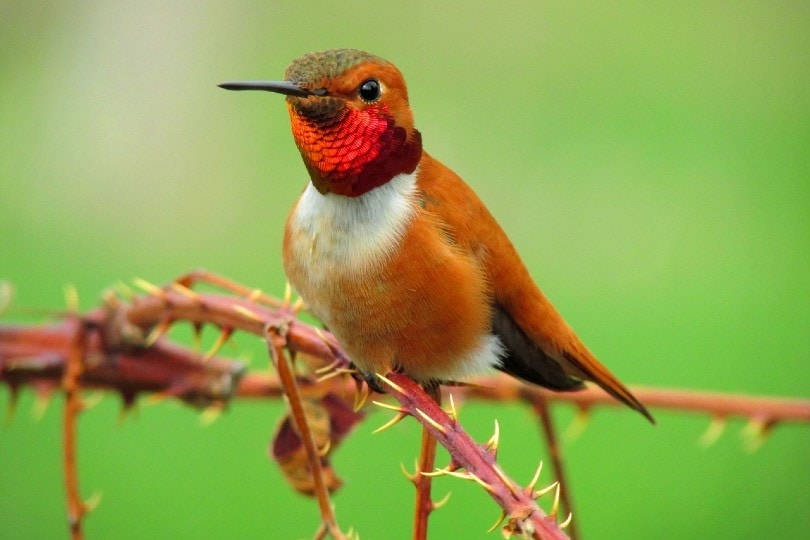
Quick, small, and colorful, hummingbirds are one of the most loved bird species. These birds are often spotted flying at unmatchable speed in New Mexico’s sky. It’s estimated that these birds travel more than 4,000 miles yearly1 at 98 km/h. Also, they have a wingbeat of 58 beats a second on average!
In New Mexico, you will find 17 hummingbird species, with 11 being recognized as regularly occurring, one as near-threatened, and the remaining six as rare. You’re most likely to witness Black-chinned Hummingbirds, Rufous Hummingbirds, Broad-tailed Hummingbirds, and Calliope Hummingbirds in New Mexico.
This guide briefly discusses the characteristics of 14 common hummingbird species in New Mexico. Let’s go through each to help you quickly identify your favorite hummingbirds on your next trip to the state.

The 14 Types of Hummingbirds in New Mexico
1. Black-chinned Hummingbird (Archilochus alexandri)

| Scientific Name: | Archilochus alexandri |
| Length: | 3.5 inches |
| Weight: | 0.1 to 0.2 ounces |
| Wingspan: | 4.3 inches |
Black-chinned hummingbirds are the most common species in New Mexico during summers. They are spotted in the state from March to November, as it is their breeding season. During their non-breeding season, these birds fly to higher mountain areas with meadows. Then, they migrate to Southern California, the Gulf Coast, and Western Mexico in the winter.
However, a few black-chinned hummingbirds are non-migratory, so they spend their winter in New Mexico. This means you can witness these birds throughout the year.
To identify them, look for dull-metallic green hummingbirds with a grayish underneath. The females have white tips on the tail and pale throat, while the males’ throat is black with purple shading. Visit your nearest canyons, rivers, or shady oak trees to find these birds sitting at treetops or tiny branches.
Black-chinned Hummingbirds love feeding spiders, nectar, and small insects. They also love nectar from flowers. In fact, the tongues of these hummingbirds can lick nectar 13 to 17 times a second. Impressive!
2. Broad-tailed Hummingbird (Selasphorus platycercus)
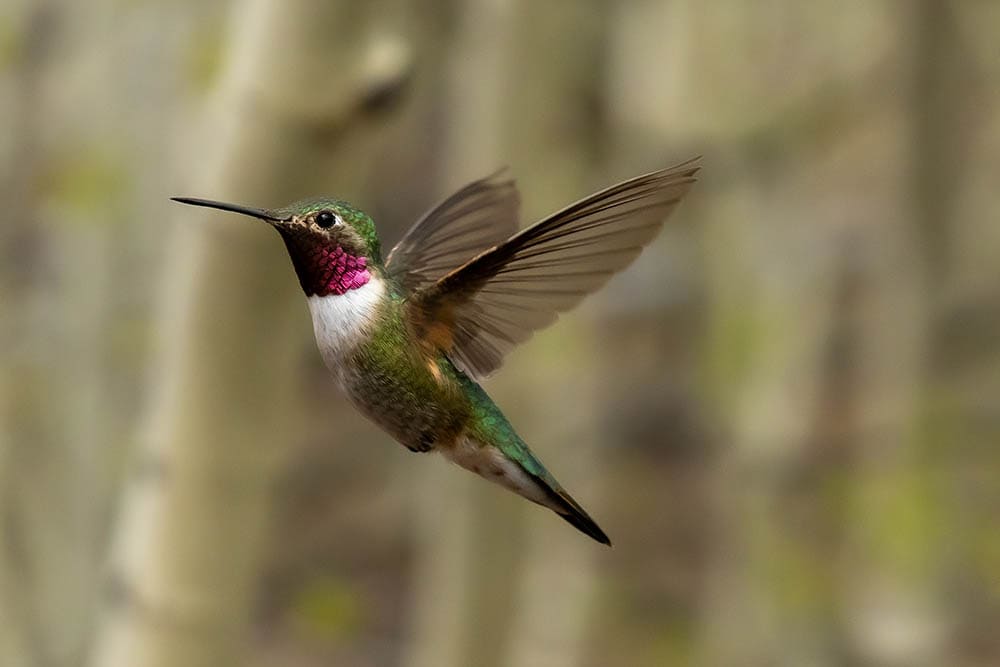
| Scientific Name: | Selasphorus platycercus |
| Length: | 3.1 to 3.5 inches |
| Weight: | 0.1 to 0.2 ounces |
| Wingspan: | 5.25 inches |
Broad-tailed Hummingbirds are the second most abundant species in New Mexico, especially during summer. Like Black-chinned Hummingbirds, they are also spotted in the state from March to November and then migrate afterward. However, some birds do not migrate.
These hummingbirds travel to Southern Mexico in the non-breeding season, but some stay on the Gulf Coast. They migrate in April, August, and September. These birds are primarily spotted in higher elevated open woodlands and meadows, ranging between 5,000 to 10,000 feet of elevation.
You can identify Broad-tailed Hummingbirds from their vivid green backs, brownish wings, and white bellies and chests. The difference between males and females is the color of the throats. Females have green patches on the cheeks and throat, while males have iridescent rose streaks.
One unique characteristic of Broad-tailed Hummingbirds is that they can adjust their body temperature and heart rate according to the climate. When it’s cold, they decrease their heart rate and body temperature and return to normal in hot weather.
These birds like flower nectar, small insects, and the sap of Sage, Red Columbine, and Larkspur. They also eat from feeders, so you can easily attract them to your yard.
3. Rufous Hummingbird (Selasphorus rufus)
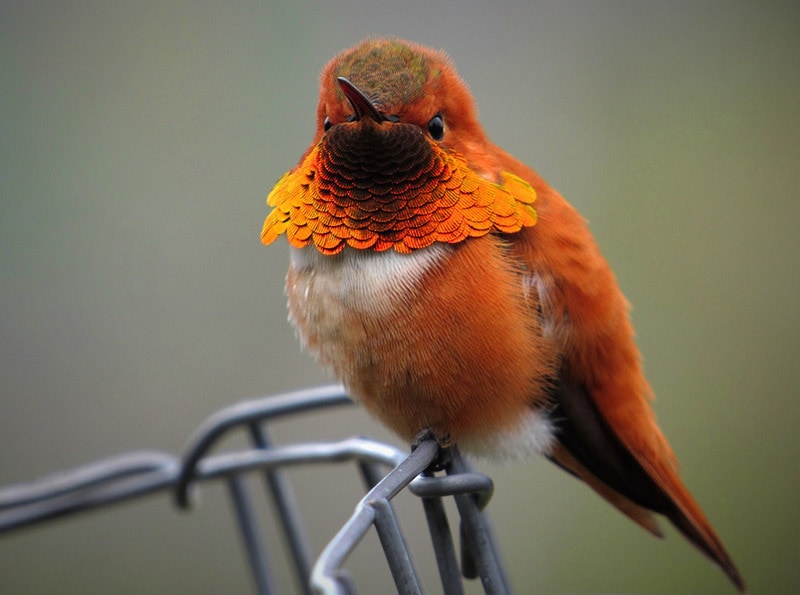
| Scientific Name: | Selasphorus rufus |
| Size: | 2.8 to 3.5 inches |
| Weight: | 0.1 to 0.2 ounces |
| Wingspan: | 4.3 inches |
Rufous Hummingbirds are the third-most widespread species in New Mexico. They are mostly spotted from June to October. In fact, Rufous Hummingbirds are famous as the longest migrating species compared to their size. They can migrate up to 4,000 miles every year.
During their breeding season, these birds stay in Northwest Canada and Alaska and then migrate to the Gulf Coast and Mexico. In spring, they migrate along the Pacific coast in February. During late summer and fall, Rufous Hummingbirds travel to the Rocky Mountains in July, August, and October.
Males have vivid orange backs, bellies, and red throats with a white patch below. On the other hand, females have greenish-brown bodies, white bellies, and rusty sides.
Visit mountain meadows or coniferous forests to witness Rufous Hummingbirds. You will see them feeding on the nectar of tubular flowers and insects (flies, ants, and gnats). These birds can get fierce when someone tries to intrude on their territory. These petite birds don’t shy from chasing humans and more giant birds, so stay cautious!
4. Calliope Hummingbird (Selasphorus calliope)
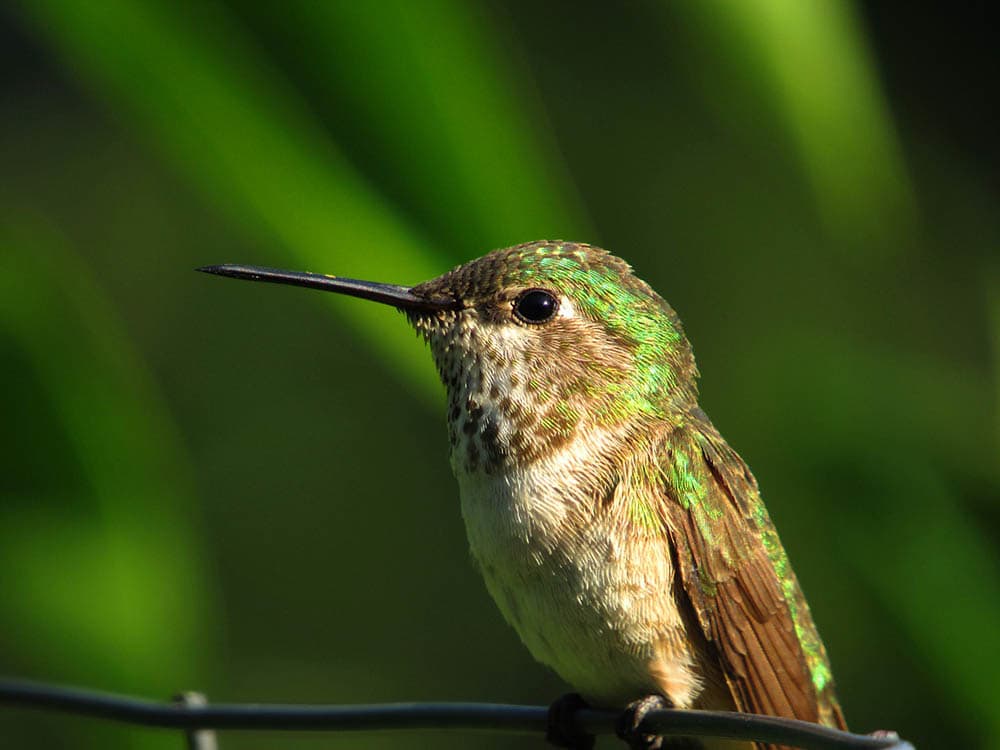
| Scientific Name: | Selasphorus calliope |
| Size: | 3.1 to 3.5 inches |
| Weight: | 0.1 ounce |
| Wingspan: | 4.3 inches |
Calliope Hummingbirds are regularly occurring species in New Mexico, but you may not find them easily. They are mainly seen in the state during April and November. They migrate to the Rocky Mountains in spring. They pass through the Pacific coast to reach their breeding spots in Colorado, California, and British Columbia.
The migration period of these hummingbirds starts in February and continues till May. Calliope Hummingbirds are recognized as the smallest bird in the US. Still, they fly 5,000+ miles every year from Mexico to Canada.
You can identify males from their vivid magenta throats, dark tails, shiny green flanks and backs, and white underneath. Females, on the other hand, do not have iridescent throats. Instead, they have pinkish-white underbodies.
Like other hummingbird species, these birds like tree saps, flower nectar, and insects. So, you can use these things in the feeders to lure them into your home.
5. Anna’s Hummingbird (Calypte anna)
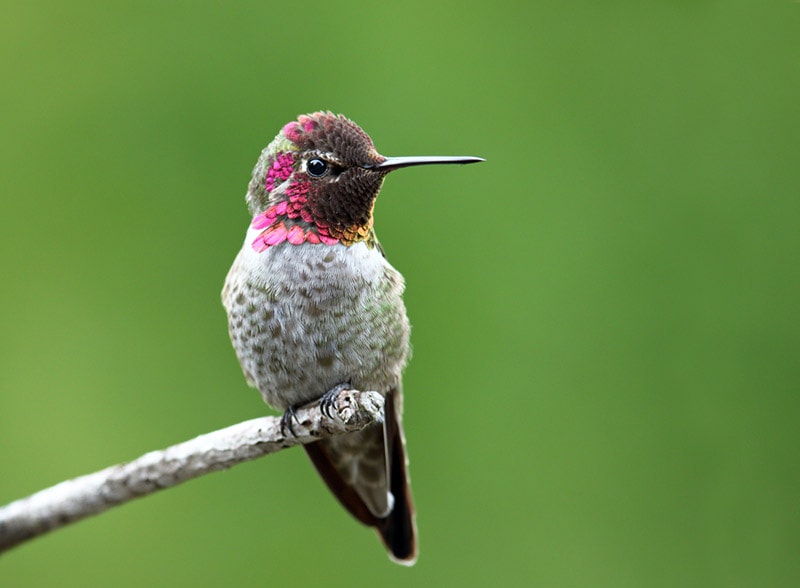
| Scientific Name: | Calypte anna |
| Size: | 3.9 inches |
| Weight: | 0.1 to 0.2 ounces |
| Wingspan: | 4.7 inches |
Anna’s Hummingbirds are one of the rarely spotted species in New Mexico. But ironically, they are the state’s regularly occurring hummingbirds. They migrate from British Columbia to Baja California in winter and summer. Some birds also travel north for winter.
Watch out for tiny hummingbirds in parks and backyards with flowers and feeders. They are gray and green, with males having bright reddish-pink throats and heads. Females have grayish throats with hints of red spots. You may also find Anna’s Hummingbirds in Savanna and Scrubs.
These hummingbirds dive dramatically during courtship. The males fly up to 135 feet in the air and then dive back to the ground, making a bursting sound from their tail feathers. You may witness this unique behavior during their breeding season if you are lucky enough.
Anna’s Hummingbirds love tree sap, nectars, and small insects. They also prefer feeding on the nectars of Eucalyptus, Castilleja, Ribes, Agave, and Silena. You can also attract these birds to your yard with feeders.
6. Broad-billed Hummingbird (Cynanthus latirostris)

| Scientific Name: | Cynanthus latirostris |
| Size: | 3.1 to 3.9 inches |
| Weight: | 0.1 ounce |
| Wingspan: | 5.1 inches |
Broad-billed Hummingbirds are rare to spot in New Mexico, despite being a regularly occurring species. These birds are native to Central Mexico and the Pacific coast. Their breeding season starts from March till September. During this period, they travel to mountain canyons in New Mexico, while some remain close to the Mexican border all year.
Broad-billed Hummingbirds are brightly colored. Both sexes have black tails and red beaks. However, the males have metallic green bodies with blue throats. Females, on the other hand, have pale bellies.
The best spots to find these birds are mountain meadows and canyon streams. These areas offer abundant foraging sources to Broad-billed Hummingbirds. They also visit feeders installed in backyards, so you can easily invite these birds to your yard.
7. Rivoli’s Hummingbird (Eugenes fulgens)

| Scientific Name: | Eugenes fulgens |
| Size: | 4.3 to 5.5 inches |
| Weight: | 0.3 ounces |
| Wingspan: | 7.1 inches |
Rivoli’s Hummingbirds are another regularly occurring species in New Mexico. Still, you will have to make extra efforts to spot them. They are residents of Central America and Mexico. However, a few travel to southern Arizona and New Mexico. Recently, Rivoli’s Hummingbirds were seen in the Gila National Forest.
To spot these birds, you must look in the pine-oak forests in high mountainous regions. These hummingbirds prefer building their nests at high elevations and visiting feeders installed in backyards.
Rivoli’s Hummingbirds are larger than other species and have more vibrant coloring. Males have emerald-green throats with dark green bodies, while females have green backs and grayish underbodies. Both sexes have unique iridescent, purple-colored crowns.
Their diet is the same as other hummingbirds, i.e., insects, nectar, and tree sap. You can include these things in your yard to witness gorgeous Rivoli’s Hummingbirds.
8. Ruby-throated Hummingbird (Archilochus colubris)
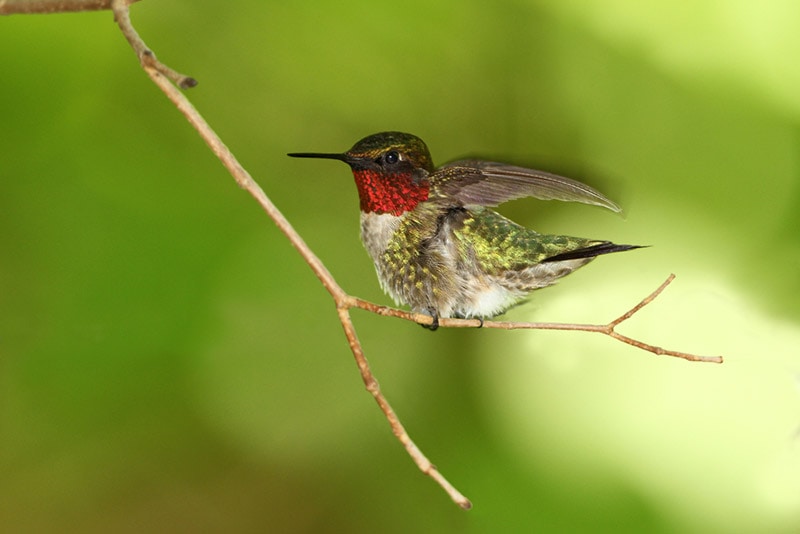
| Scientific Name: | Archilochus colubris |
| Size: | 2.8 to 3.5 inches |
| Weight: | 0.1 to 0.2 ounces |
| Wingspan: | 3.1 to 4.3 inches |
Ruby-throated Hummingbirds are accidental or rare species in New Mexico. They reach the US around February and wait till May to arrive in Canada and the northern states for breeding. Males typically arrive before the females in spring.
The migration period of Ruby-throated Hummingbirds starts in August and September when they migrate south. These birds gather along the Gulf Coast of Texas in September before taking off to the south for winter. So, ensure you are looking for these birds at the right time of the year.
The bright-green Ruby-throated Hummingbirds are spotted in woodland edges, flowering gardens, and in towns at feeders. They have gray-white underbodies with a deep red throat in males and brown crowns in females. You may find these birds catching insects from the air or spider webs and feeding on nectar from blooms.
9. Violet-crowned Hummingbird (Amazilia violiceps)
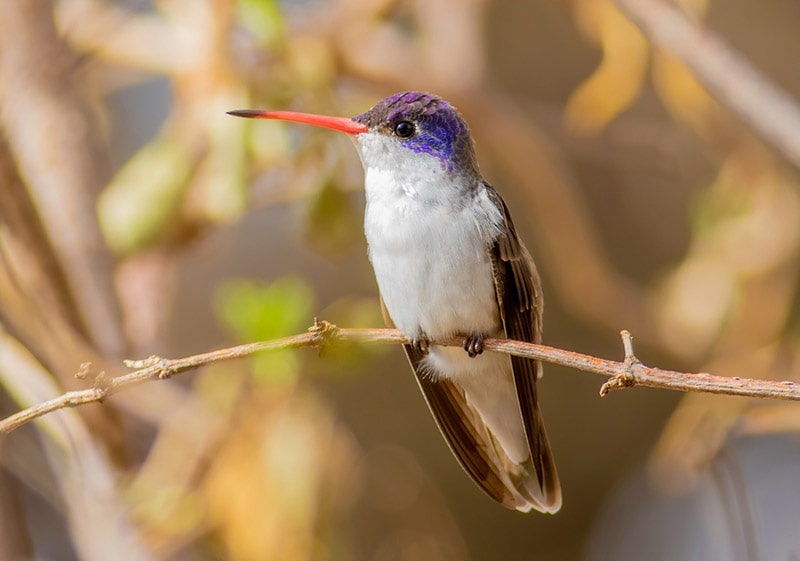
| Scientific Name: | Amazilia violiceps |
| Size: | 4 inches |
| Weight: | 0.1 to 0.2 ounces |
| Wingspan: | 6 inches |
Violet-crowned Hummingbirds are one of the rare species in New Mexico. Their range is from southwestern New Mexico to southwestern Mexico. They reach the US in February and nest in New Mexico from April to September. These birds migrate to the south for winter, but a few stay back throughout the winter.
Violet-crowned Hummingbirds have a unique violet cap. Both sexes are medium-sized with dark olive green backs, red bills with black tips, and white underbodies. The females are more brightly colored than males, having bluish-green metallic tails with a blue band across the end.
Look for these hummingbirds in tropical deciduous forests and near oak trees and scrubs. They love to nest in such places!
10. Costa’s Hummingbird (Calypte costae)
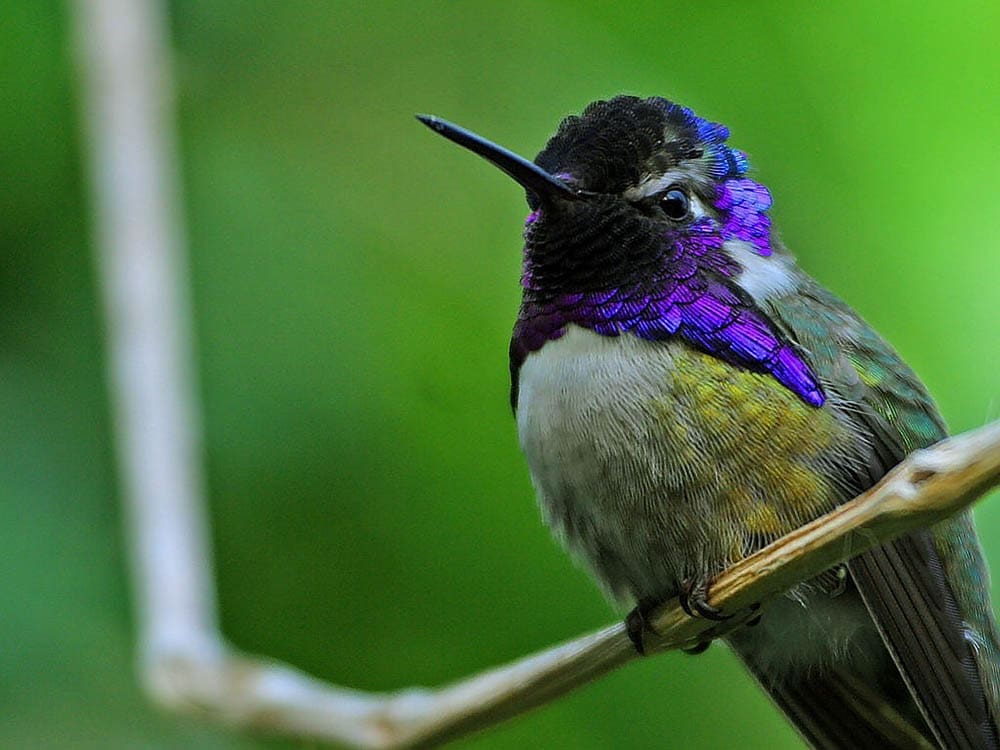
| Scientific Name: | Calypte costae |
| Size: | 3.5 inches |
| Weight: | 0.1 ounces |
| Wingspan: | 4.3 inches |
Costa’s Hummingbirds are another regularly occurring species in the state, last spotted near Whitmire Canyon Wilderness Study Area and Silver City. These birds are natives of southern California, Baja California, and southwestern Arizona. They migrate from the Pacific Coast of Mexico to Arizona in winter and Nevada and Utah in summer for breeding.
You can identify these birds from their rich purple patches on their throats and purple crowns. They have green bags and white bellies with green shading on the sides. Unfortunately, females don’t have vibrant purple colors on their bellies. Instead, they are primarily white.
This species loves desert habitats but is also spotted in scrub and deciduous forests. These places provide many types of plants to Costa’s Hummingbirds for forage. You can attract them to your yard by creating a favorable environment.
11. Lucifer Hummingbird (Calothorax lucifer)

| Scientific Name: | Calothorax lucifer |
| Size: | 3.9 inches |
| Weight: | 0.1 ounce |
| Wingspan: | 4 inches |
Lucifer Hummingbirds are a rare sight in New Mexico because of their desert habitat. They spend their breeding season in northern Mexico, Arizona, Texas, and New Mexico from March to September. Then, when their non-breeding season starts, they travel to central Mexico.
You should look for these birds in desert areas and dry canyons. They have forked tails, green backs, and curved bills. Males have purple throats. Lucifer Hummingbirds love to feed the nectar of flowering ocotillo, agaves, and century plants.
If you spot these birds during their breeding season, you will see males making sudden dives in front of the females to impress them. In fact, they dive from 100 feet, which is impressive considering their small body size and weight.
12. Blue-throated Mountain-gem (Lampornis clemenciae)

| Scientific Name: | Lampornis clemenciae |
| Size: | 4.3 to 4.7 inches |
| Weight: | 0.3 ounces |
| Wingspan: | 2.3 to 3.1 inches |
The Blue-throated Mountain-gems are considered the largest hummingbird species in the US. They are rare in New Mexico, despite being a regularly occurring hummingbird species in the state. These birds reside in Mexico, but some travel shorter distances towards southeastern Arizona and Texas.
The male Blue-throated Mountain-gems have bright blue throats. Both males and females have bronzy-green backs, grayish underneath, and black tails with white tips. The best spot to find these birds is mountain woodlands close to streams. Places with blooms and feeders are also the ideal habitats for Blue-throated Mountain-gems.
When attracting these birds to your yard, remember that they prefer feeding in the morning and afternoon. So, plan your schedule accordingly to make the most of your efforts.
13. Allen’s Hummingbird (Selasphorus sasin)
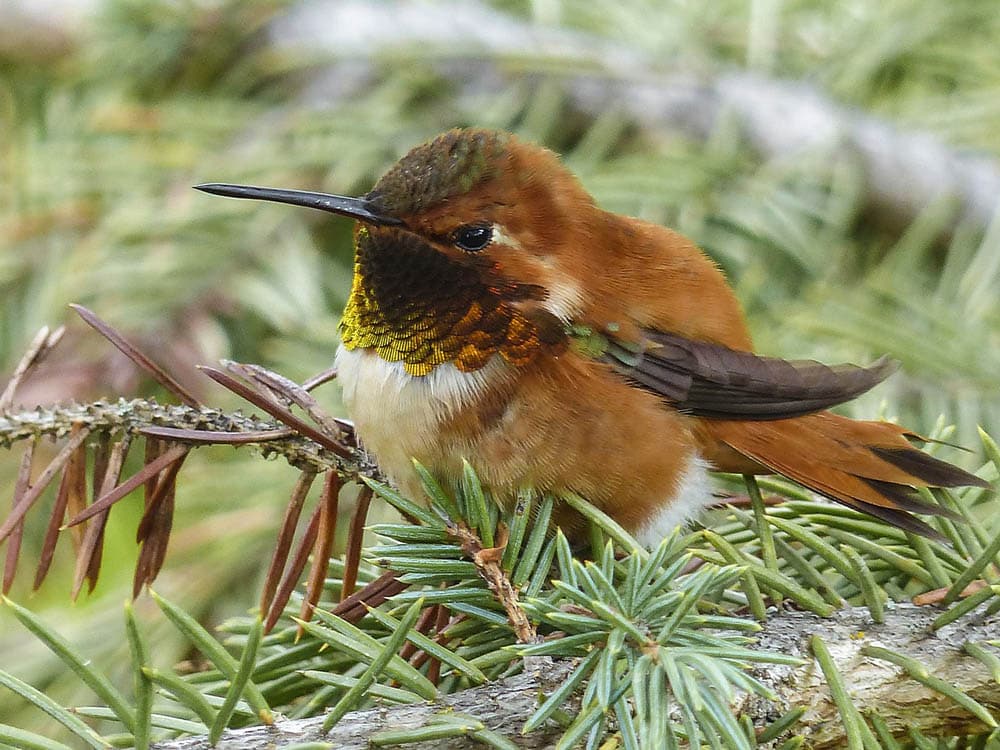
| Scientific Name: | Selasphorus sasin |
| Size: | 3.5 inches |
| Weight: | 0.1 ounce |
| Wingspan: | 4.3 inches |
One accidental species in New Mexico, Allen’s Hummingbird, is only spotted by the lucky bird watchers. These birds were recently seen in 2005 near Lake Roberts. This hummingbird species prefers staying in Mexico during winter.
Some Allen’s hummingbirds travel to the Pacific Coast in Oregon and California in January. The others are residents in Los Angeles and central Mexico throughout the year.
It is relatively easy to distinguish male Allen’s Hummingbirds from females. Look at the throats of these birds. Males have bright reddish-orange throats, while females have dull coloring. Males also have orange tails, bellies, and eye patches. Both sexes have coppery-green backs and long bills.
Many beginner birdwatchers confuse Allen’s Hummingbirds with Rufous Hummingbirds. That’s understandable since it’s difficult to differentiate both species in their inhabited coastal forests and scrubs.
14. Berylline Hummingbird (Saucerottia beryllina)

| Scientific Name: | Saucerottia beryllina |
| Size: | 3 to 4.25 inches |
| Weight: | 0.14 to 0.18 ounces |
| Wingspan: | 5.75 inches |
Lastly, Berylline Hummingbirds are another accidental species in New Mexico, last seen in 2006 by the New Mexico Historical Records in Mimbres. These birds are found in open woodlands from Mexico to Honduras. Not only that but they are also spotted in oak and pine forests and shady canyons.
Berylline Hummingbirds are widespread in southeastern Arizona from April to November. It’s their breeding season. To spot these birds, you must head toward the Huachuca, Santa Rita, and Chiricahua Mountains. This hummingbird species are solitary birds that can become aggressive when defending its area.
So, maintain a distance during sight-seeing and look for metallic green hummingbirds with metallic green. These birds have grayish underneath, red wings, reddish-orange lower bills, and black upper bills.

Conclusion
Witnessing hummingbirds is always a pleasure for bird lovers. If you are visiting New Mexico or already live there, consider it your lucky charm since it is home to many beautiful hummingbird species.
Most of these species are regularly occurring, including Black-chinned Hummingbirds, Broad-billed Hummingbirds, and Rufous Hummingbirds. The others are accidentally occurring.
To witness your favorite hummingbirds, you must memorize each species’ characteristics and always carry your binoculars. Since most hummingbird species are rare in New Mexico, you can’t afford to miss any chances!
Featured Image Credit: Avia5, Pixabay
Table of Contents
- The 14 Types of Hummingbirds in New Mexico
- 1. Black-chinned Hummingbird (Archilochus alexandri)
- 2. Broad-tailed Hummingbird (Selasphorus platycercus)
- 3. Rufous Hummingbird (Selasphorus rufus)
- 4. Calliope Hummingbird (Selasphorus calliope)
- 5. Anna’s Hummingbird (Calypte anna)
- 6. Broad-billed Hummingbird (Cynanthus latirostris)
- 7. Rivoli’s Hummingbird (Eugenes fulgens)
- 8. Ruby-throated Hummingbird (Archilochus colubris)
- 9. Violet-crowned Hummingbird (Amazilia violiceps)
- 10. Costa’s Hummingbird (Calypte costae)
- 11. Lucifer Hummingbird (Calothorax lucifer)
- 12. Blue-throated Mountain-gem (Lampornis clemenciae)
- 13. Allen’s Hummingbird (Selasphorus sasin)
- 14. Berylline Hummingbird (Saucerottia beryllina)
- Conclusion
About the Author Jeff Weishaupt
Jeff is a tech professional by day, writer, and amateur photographer by night. He's had the privilege of leading software teams for startups to the Fortune 100 over the past two decades. He currently works in the data privacy space. Jeff's amateur photography interests started in 2008 when he got his first DSLR camera, the Canon Rebel. Since then, he's taken tens of thousands of photos. His favorite handheld camera these days is his Google Pixel 6 XL. He loves taking photos of nature and his kids. In 2016, he bought his first drone, the Mavic Pro. Taking photos from the air is an amazing perspective, and he loves to take his drone while traveling.
Related Articles:
Monocular vs Telescope: Differences Explained (With Pictures)
10 Types of Hummingbirds in Arkansas (With Pictures)
8 Types of Hummingbirds in Nebraska (With Pictures)
5 Types of Hummingbirds in Idaho (With Pictures)
3 Types of Hummingbirds in Mississippi (With Pictures)
8 Types of Hummingbirds in Kansas (With Pictures)
5 Types of Hummingbirds in West Virginia (With Pictures)
5 Types of Hummingbirds in Ohio (With Pictures)
